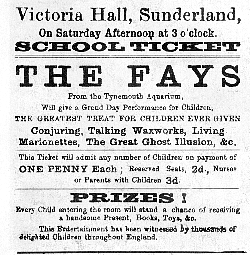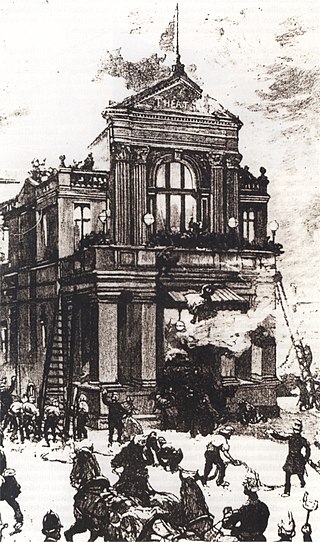
Hogmanay is the Scots word for the last day of the old year and is synonymous with the celebration of the New Year in the Scottish manner. It is normally followed by further celebration on the morning of New Year's Day and, in some cases, 2 January—a Scottish bank holiday. In a few contexts, the word Hogmanay is used more loosely to describe the entire period consisting of the last few days of the old year and the first few days of the new year. For instance, not all events held under the banner of Edinburgh's Hogmanay take place on 31 December.

Braehead is a commercial development located at the former site of Braehead Power Station in Renfrew on the south bank of the River Clyde in Renfrew, Renfrewshire. It is particularly notable for its large shopping centre, arena and leisure facilities.

The Summerland disaster occurred when a fire spread through the Summerland leisure centre in Douglas on the Isle of Man on the night of 2 August 1973. 50 people were killed and 80 seriously injured. The scale of the fire has been compared to those seen during the Blitz.

The Beverly Hills Supper Club fire in Southgate, Kentucky, is the seventh deadliest nightclub fire in history. It occurred on the night of May 28, 1977, during the Memorial Day holiday weekend. A total of 165 people died and more than 200 were injured as a result of the blaze.

On Monday, December 1, 1958, a fire broke out at Our Lady of the Angels School in Chicago, Illinois, shortly before classes were to be dismissed for the day. The fire originated in the basement near the foot of a stairway. The elementary school was operated by the Archdiocese of Chicago and had an enrollment of approximately 1600 students. A total of 92 pupils and three nuns ultimately died when smoke, heat, fire, and toxic gases cut off their normal means of egress through corridors and stairways. Many more were injured when they jumped from second-floor windows which, because the building had a raised basement, were nearly as high above ground as a third floor would be on level ground, approximately 25 feet (7.6 m).

The Bradford City stadium fire occurred during a Football League Third Division match on Saturday, 11 May 1985 at the Valley Parade stadium in Bradford, West Yorkshire, England, killing 56 spectators and injuring at least 265. The stadium was known for its antiquated design and facilities, which included the wooden roof of the main stand. Previous warnings had also been given about a major build-up of litter in the cavity below the seats in the stand. The stand had been officially condemned and was due to be replaced with a steel structure after the season ended.

The Iroquois Theatre fire was a catastrophic building fire in Chicago, Illinois, that broke out on December 30, 1903, during a performance attended by 1,700 people. The fire caused 602 deaths and 250 non-fatal injuries. It ranks as the worst theater fire in the United States, surpassing the carnage of the Brooklyn Theatre fire of 1876, which claimed at least 278 lives.

The 1985 Manchester Airport disaster occurred when British Airtours Flight 28M, an international passenger flight, was en-route from Manchester Airport to Corfu International Airport. It caught fire on takeoff on 22 August 1985, resulting in 55 fatalities.

A crash bar is a type of door opening mechanism which allows users to open a door by pushing a bar. While originally conceived as a way to prevent crowd crushing in an emergency, crash bars are now used as the primary door opening mechanism in many commercial buildings.

The Rhythm Club fire was a fire in a dance hall in Natchez, Mississippi on the night of April 23, 1940, which killed 209 people and severely injured many others. Hundreds of people were trapped inside the building. At the time, it was the second deadliest building fire in the history of the nation. It is now ranked as the fourth deadliest assembly and club fire in U.S. history.

The Laurier Palace Theatre fire, sometimes known as the Saddest fire or the Laurier Palace Theatre crush, occurred in a movie theatre in Montreal, Quebec, on January 9, 1927, killing 78 people. The theatre was located at 3215 Saint Catherine Street East, just east of Dézéry St.
The Luzhniki disaster was a deadly crowd crush that took place at the Grand Sports Arena of the Central Lenin Stadium in Moscow during the 1982–83 UEFA Cup match between FC Spartak Moscow and HFC Haarlem on 20 October 1982. According to the official enquiry, 66 FC Spartak Moscow fans, mostly adolescents, died in the crush, which made it Russia's worst sporting disaster. The number of fatalities in this crush was not officially revealed until seven years later, in 1989. Until then, this figure varied in press reports from 3 to 340 fatalities. The circumstances of this disaster are similar to those of the second Ibrox disaster in Scotland.

The Victoria Hall disaster occurred on 16 June 1883 at the Victoria Hall in Sunderland, England, when the distribution of free toys caused a crowd crush resulting in 183 children to be crushed to death due to compressive asphyxia.
The 1981 Bangalore circus fire occurred on 7 February 1981 at the Venus Circus in Bangalore, Karnataka, India, where more than 92 people died, the majority of them being children.

Paolo Giovanni Nutini is a Scottish singer-songwriter from Paisley. Nutini's debut album, These Streets (2006), peaked at number three on the UK Albums Chart. Its follow-up, Sunny Side Up (2009), debuted at number one on the UK Albums Chart. Both albums have been certified quintuple platinum by the British Phonographic Industry. Five years later, Nutini released his third studio album, Caustic Love, in April 2014, which debuted at number one on the UK Album Charts and was certified platinum by the BPI. In July 2022, he released his fourth album, Last Night in the Bittersweet.
Cinema Statuto was a movie theater located in Turin, Italy, when on 13 February 1983, at 18:15, during the projection of La Chèvre, a fire caused the death of 64 people as a result of smoke inhalation. According to statements by Raimondo Capella, the owner of the cinema, the flames spread from an old curtain. This was the largest disaster to have occurred after World War II in Turin.

The Club Cinq-Sept fire was a major blaze at a nightclub just outside Saint-Laurent-du-Pont, Isère, France, on Sunday, 1 November 1970. The fire claimed the lives of 146 people, almost all of whom were aged between 17 and 30. The scale of the disaster shocked the country. Subsequent official enquiries revealed a catalogue of shortcomings, oversights and evasions with regard to fire safety at both local and département level. Criminal charges were brought against a number of people; some received suspended jail sentences.

The 1971 Ibrox disaster, also known as the Second Ibrox Disaster, was a crush among the crowd at an Old Firm football game, which led to 66 deaths and more than 200 injuries. It happened on 2 January 1971 in an exit stairway at Ibrox Park in Glasgow, Scotland. It was the worst football disaster until the Bradford City stadium fire in Bradford, England, in 1985. This was followed by 97 deaths in the Hillsborough disaster in Sheffield, England, in 1989.
Events from the year 1929 in Scotland.

On 5 September 1887, a fire broke out in the backstage area of the Theatre Royal in Exeter, England, during the production of The Romany Rye. The fire caused panic throughout the theatre, with 186 people dying from a combination of the direct effects of smoke and flame, crushing and trampling, and trauma injuries from falling or jumping from the roof and balconies.


















